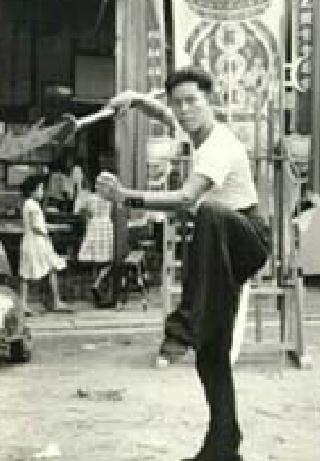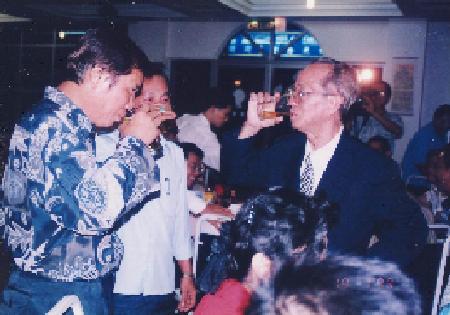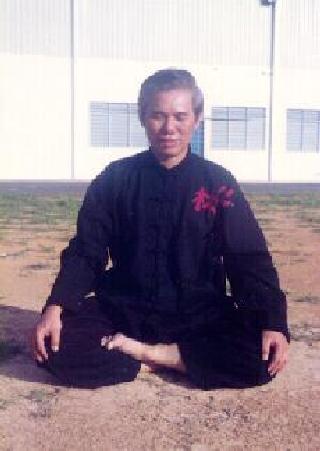July 2005 (Part 2)
SELECTION OF QUESTIONS AND ANSWERS

Sifu Wong's first master, Sifu Lai Chin Wah, more popularly known as “Uncle Righteousness”
Question 1
After reading a Buddhist book entitled “Understanding the Mind”, all sorts of questions began to race through my mind. I now consider myself a Buddhist because my intuition is guiding me towards it, and I agree with the Buddhist books I've read. However I began to think how can I logically adhere to one philosophy if I haven't read all the others? I don't have a desire to spend my life tracking down every philosophical work ever written but my mind was telling me this is the only way to know that I'm following the right way.
— Watts, UK
Answer
Your concept that you must have read and understood all the philosophies in the world before you can wisely choose the best, is both incorrect and unrealistic. It is like saying you must have worked in all jobs before you can choose an occupation that suits you, or you must know all the girls in the world before you can choose your wife.
The correct concept is to choose the best from what is available. You have been exposed to various philosophies of life. Now just choose the one you think is best for you.
Your choise of Buddhism is wise. Actually even in Buddhism there are many different approaches and ideals. It is said that there are 48,000 doors to Buddhism, which is a figurative way of saying there are many different expedient means to suit the different nature, aspirations and developmental stages of different people practicing Buddhism.
But the Buddha himself has made things very simple for us. He says that the essence of Buddhism consists of the following three practices:
- Avoid all evil.
- Do good.
- Cultivate the mind.
Following our Ten Shaolin Laws is an excellent, practical way to avoid evil and do good. Practicing the chi kung exercises you have learnt from me is an excellent way not just to cultivate chi but also to cultivate your mind.
Question 2
I used to read a lot of philosophy books trying to understand the nature of reality, but it leads me to confusion, anxiety and depression. Sifu since I was in my mid teens I had a strong desire to understand the nature of reality. I don't know where this came from or why. However I do know that unfulfilment of that desire is what causes me a lot of unpleasant feelings. My question is how can I stop this train of thought. I now believe that chi kung, kung fu and Buddhism will help me.
Answer
You have read a lot about philosophy and reality, and you have chosen a most noble philosophy and practice, i.e. Buddhism. Now, stop worrying and stop intellectualizing. Just practice. In other words, every day of your life avoid evil, do good and cultivate your mind.
You should not do these three things as three boring obligations, but as joyful aspirations. You should not dull your mind by asking fruitless questions like why should one avoid evil, or is this way of doing good better than that way. Just avoid evil and do good, and enjoy it.
Don't ask questions like why do I cultivate my mind or how should I cultivate my mind. It is not that these questions are unimportant. They are important for other people who have not started their cultivation, and who have not thought deeply enough on these questions. But you have gone passed that. You have thought long enough on these questions, and have come to a very wise solution, that is you have decided to cultivate following the way taught by the Buddha. So just carry on with your noble journey.
You can stop your fruitless train of thoughts simply by stopping it. Let us take another analogy. You are walking towards a particular place, but you have found out that place is not actually where you want to go. How do you stop walking there? Just stop walking there. Don't fuss over your decision and don't ask unnecessary questions. Just stop walking there.
In practical terms, as soon as a fruitless thought arises in your mind, just stop thinking about it — without fuss and without question. It is just like what you do when you keep your mind clear when practicing chi kung.
The Buddha has made it very clear in his teaching that one understands reality not by reading about it or thinking about it, but by experiencing it. As an analogy at a very mundane level, one does not understand the taste of a mango by reading or thinking about it, but by eating a mango to experience its taste.
Our chi kung exercises enable us to experience reality ranging from a very basic level to a very advanced level. At a basic level, we feel peaceful with outselves and with the cosmos. At a very high level, we have a glimpse of our Original Face, or in Western terms, we see God. You can read some of these experiences in our Shaolin Wahnam Discussion Forum.
But you need not be in a hurry to see your Original Face or to meet God. Your Original Face or God is always there available to you when you are ready. In today's world when many people are stressful, just to be peaceful and happy is already a fantastic result of your chi kung practice, which is cultivating your mind.

Sifu Wong drinking to the health of his master, Sifu Ho Fatt Nam, the third generation successor of the Southern Shaolin Temple
Question 3
Good day sifu! I find your book, “The Complete Book of Shaolin”, the best book ever for me so much that it is the only book I want to read! That's why I have given many of your books to many libraries in Sweden so that many people can read them now. I wonder do you intend in the future to write some books like the complete book of chi kung or the complete book of dim mak or dian xue?
— Hugo, Sweden
Answer
Thank you for your kind words, and for donating my books to libraries in Sweden. That is very generous of you.
I have written two books on chi kung, namely “The Art of Chi Kung” and “Chi Kung for Health and Vitality”. Some people regard “The Art of Chi Kung” as the complete book of chi kung because it gives a comprehensive explanation of the history, philosophy and practice of chi kung.
Yet, there is still a lot of very useful chi kung knowledge that is at present kept only in classical Chinese texts, but which can greatly benefit our modern world. I hope to write some books on such knowledge later on.
However, I have no intention to explain publicly the secrets of “dim mark”, or “dan xue” in Mandarin pronunciation. Although “dim mak” is actually a compassionate art where a master can temporarily disable the fighting abilities of an opponent by striking particular energy points on the opponent's body instead of permanently injuring him, this secretive art, which has been popularly but wrongly translated as the “death touch”, can be misused by unscrupulous martial artists. In the past this art was taught only to selected disciples who had proven to be of high moral character.
Question 4
What happens if two marvelous masters fight each other? Who wins?
Answer
The one with greater skills, not the one with more techniques, wins. Skills here refer particularly to force, speed and precision.
Question 5
Is dim mak the highest martial art technique that man can learn?
Answer
There is no one definite answer for this question, because the answer depends on a few variables.
In some ways dim mark is the highest martial art technique. But we must not forget that in combat, skills are more important than techniques in deciding victory. For example, a master who is very skilful in a simple thrust punch, i.e. his punch is so very fast, accurate and powerful, can defeat a master who is very good at dim mark techniques but lacks skills.
But if we use the term “martial art” in a wide sense, even when we just limit our discussion to techniques and artificially leave out skills, dim mark is not the highest. The technique of Standing Zen, where a practitioner just stands upright, be relaxed and think of nothing, is of a higher level. It is because Standing Zen can lead the practitioner to a transcendental level, such as having a glimpse of his Original Face, whereas no matter how effective a dim mak practitioner is in using this technique to injure his opponents, he still remains at the phenomenal level.
In Shaolin Wahnam we consider Standing Zen a martial art technique because all Shaolin Wahnam students who practice Shaolin Kungfu learn this technique, and they learn it on the very first day of their Shaolin training. All Wahnam Taijiquan students also learn this technique on the very first day of their training, but it is called “Entering Tao” in Wahnam Taijiquan.
All other Shaolin Wahnam students who do not practice Shaolin Kungfu or Taijiquan but practice various forms of chi kung like “Generating Energy Flow” and “Golden Shower” also learn this technique on their first day, where it is called “Entering into a Chi Kung State of Mind”.

Sifu Wong in Sitting Meditation, which is the highest technique as it leads to Enlightenment
Question 6
What happens if a marvelous great master of dim mak fights another marvelous great master of Cosmos Palm or of other techniques.
Answer
When a real great master of dim mak fights a real great master of Cosmos Palm, both of them will realize the internal force of each other, and that either one could kill or seriously injure the other. Hence, the most likely outcome is that after a few exchanges where they test and confirm each other's force, they would disengage themselves from the fight and greet each other respectfully. A great master knows that being alive and possibly win a good friend is certainly better than to be injured or dead.
However, if the fight for some reason must go on, they will try to avoid hurting each other. Instead of striking the opponent, they would merely touch his skin or stop an inch or two away. In kungfu culture this is known as “dim tou wei tzi” (Cantonese pronunciation). The receiving person would graciously acknowledge defeat, and the winner would say something like “seng yeong”, which is a concise and figurative way of saying “You are a better fighter, but you are so gracious to fight below your normal level and let me win.”
Question 7
I just wonder which of all the techniques that exist in martial art is the most powerful or the highest?
Answer
In kungfu circles, there are what is called “the three ultimate arts”. They are One-Finger Zen, Strike-Across-Space Palm, and Marvelous Fist. All these three are Shaolin arts.
A One-Finger Zen master can “dot” the energy points of an opponent from a distance of 36 steps. A Strike-Across-Space Palm master can strike an opponent from a distance of 72 steps. A Marvelous Fist master can strike an opponent from a distance of 108 steps.
Strictly speaking it is not the technique that is important; it is the master's internal force.
Notwithstanding this, in our school what we consider the highest technique or skill is Sitting Meditation. We consider meditation a martial art technique or skill because it is taught in our Shaolin Kungfu and Wahnam Taijiquan. It is the highest because it leads to the greatest achievement any being can ever attained, i.e. Englightenment.
Question 8
Have you met some great masters who were alive? If yes, can you tell us their names?
Answer
Yes, two of the greatest masters I met when they were alive were Sifu Lai Chin Wah and Sifu Ho Fatt Nam.
Sifu Lai Chin Wah was more popularly and respectfully known in kungfu circles as “Uncle Righteousness”. In a society where he lived when law enforcement by the authorities was not easy, many people went to him to help settle disputes, which he always did so fairly and righteously.
Sifu Ho Fatt Nam was the third-generation succssor of the Venerable Jiang Nan from the southern Shaolin Temple. Some people regarded Sifu Ho Fatt Nam as a bodhisattva because of his spiritual guidance and his having saved many people. I had very good karma to learn from Uncle Righteousness and Sifu Ho Fatt Nam.
What I have learnt from these two of the greatest masters is not just kungfu but how to have good health, mental freshness, vitality, compassion, cosmic wisdom, and a rich, meaningful life that is rewarding for myself, my family, my students and other people. My school, Shaolin Wahnam, is named after them.
LINKS
Selected Reading
- My Life Changing Experiences — Emiko Hsuen
- Definitive Recovery from a Hitherto Non-Curable Disease called Endometriosis — Emiko Hsuen
- Combat Sequences of Wahnam Taijiquan (Revised Version)
- The Evolution of Taijiquan from Shaolinquan
- Right and Wrong Ways to Yield in Wahnam Taijiquan
- Why Shaolin Kungfu is the Greatest Martial Art
